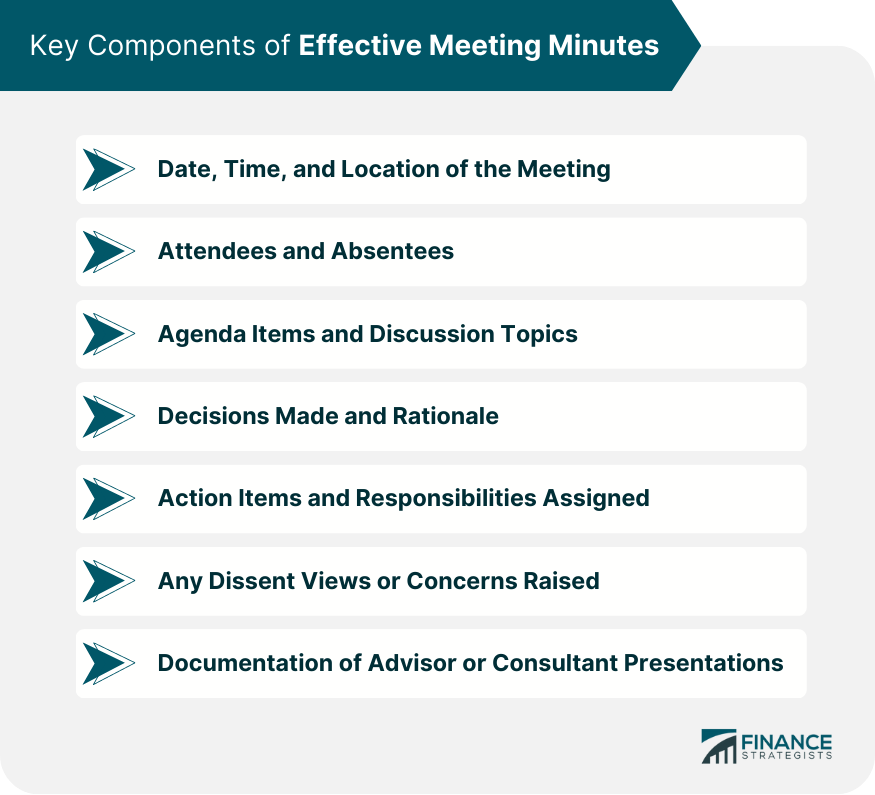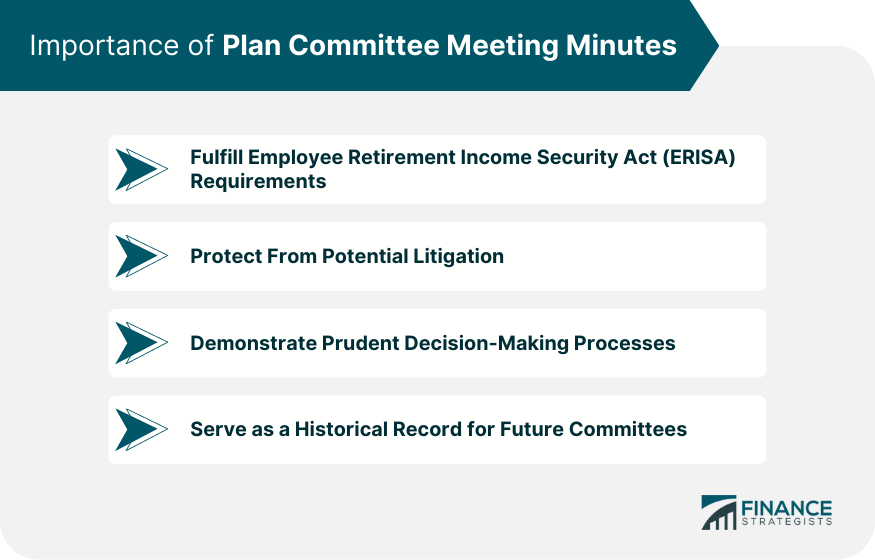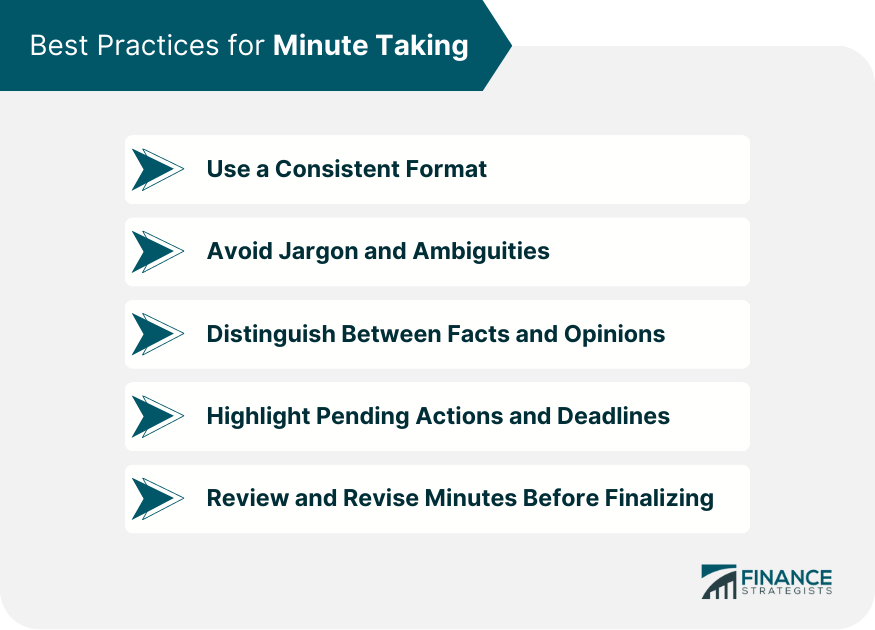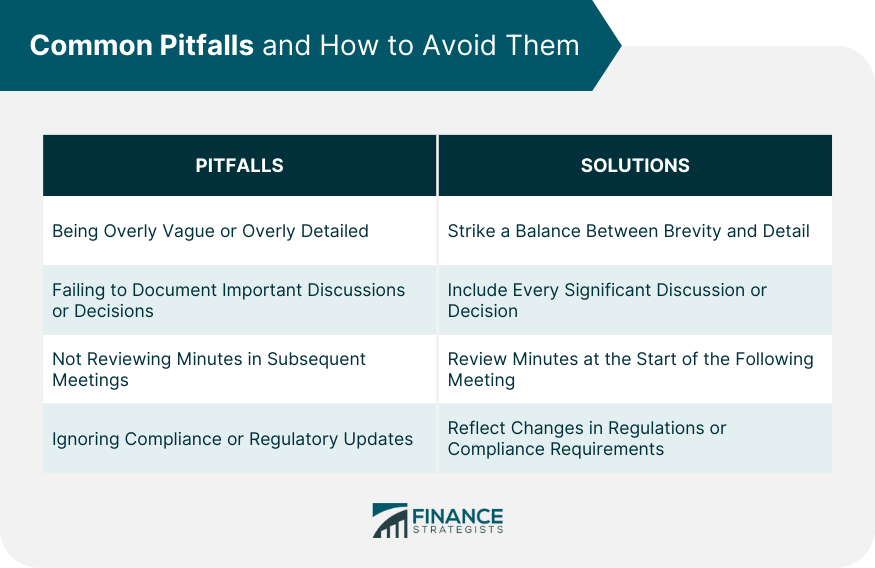Plan Committee Meeting Minutes are the official written records documenting the discussions and decisions made during retirement plan committee meetings. The primary purpose of these minutes is to provide a clear and concise summary of what was discussed, what decisions were taken, and why. They serve as proof of fiduciary oversight, ensuring that committee members are acting in the best interests of the plan participants and beneficiaries. These minutes also help maintain transparency, providing a clear trail of decision-making processes for legal, compliance, and auditing purposes. Additionally, they serve as a valuable reference, guiding future decision-making and ensuring consistency in the plan's management over time. In essence, Plan Committee Meeting Minutes play a crucial role in prudent retirement plan management and governance. Meeting minutes are legally required documents, and their absence can lead to severe consequences. Under the Employee Retirement Income Security Act (ERISA), plan committees are required to keep detailed records of their activities, including decisions about investments and administration. Without proper documentation, the committee may be unable to prove compliance with ERISA requirements, resulting in penalties or litigation. Meeting minutes serve the interests of plan participants and sponsors by providing a historical record of the retirement plan's management. They help ensure that fiduciary duties are being fulfilled, which increases trust and engagement among plan participants. For plan sponsors, they reduce the risk of litigation by demonstrating prudent decision-making. Each set of minutes should start with essential logistical details such as the date, time, and location of the meeting. This information helps establish the context and timeline of the committee's decisions. The names of those present and absent, including their roles, should be included. This ensures accountability for decisions made and identifies who may need to be updated on meeting outcomes. Every topic discussed in the meeting should be recorded in the minutes, including the primary points of conversation for each item. This ensures that important discussions are not lost to memory and provides a framework for future agenda setting. Key to the minutes is the documentation of decisions made and the reasons behind them. This is crucial for demonstrating the committee's prudence and rational decision-making processes, as well as providing a reference for future decision-making. All tasks arising from the meeting should be clearly recorded, along with who is responsible for each action. This not only keeps committee members accountable but also ensures that tasks are not forgotten or overlooked. If any members disagreed with a decision, their views should be noted in the minutes. This shows that all voices were heard and can be important in the event of future legal challenges. If an advisor or consultant presented at the meeting, this should be documented, including their advice or recommendations and any subsequent committee actions in response. ERISA requires plan committees to act prudently and for the exclusive benefit of plan participants and beneficiaries. Detailed, accurate minutes demonstrate that the committee is meeting these obligations and can be invaluable in an audit or legal challenge. By documenting their decision-making processes, committees create a protective record that can be used to defend against accusations of imprudent or disloyal conduct. This is especially important in a litigious environment where retirement plan decisions are frequently scrutinized. The detailed documentation of decisions, along with their rationale and any supporting discussions or presentations, shows that the committee is making informed, rational decisions. This not only complies with ERISA's prudence requirement but also builds trust among plan participants and other stakeholders. Minutes provide a record of past decisions, which can guide future committees. This is particularly valuable when there is turnover in committee membership, as it ensures continuity and consistency in the plan's management. Use a Consistent Format: Minutes should follow a consistent format, making it easy to locate information. This could include standard sections like 'Decisions Made,' 'Action Items,' and 'Dissenting Views.' Avoid Jargon and Ambiguities: Minutes should be clear and concise, avoiding technical jargon where possible. Any necessary technical terms should be clearly defined to ensure all readers can understand them. Distinguish Between Facts and Opinions: The minutes should clearly distinguish between factual information and personal opinions or speculation. This helps ensure the minutes are an accurate reflection of the meeting and prevents misunderstandings. Highlight Pending Actions and Deadlines: Action items and their deadlines should be prominently displayed in the minutes. This ensures everyone knows their responsibilities and when they need to be completed. Review and Revise Minutes Before Finalizing: Minutes should be reviewed and revised before being finalized to ensure accuracy. All committee members should have the opportunity to provide feedback and correct any errors or omissions. Minutes should strike a balance between brevity and detail. Too much detail can make the minutes confusing and difficult to use, while too little detail can fail to provide a complete picture of the meeting. Every significant discussion or decision should be included in the minutes. Failure to do so can result in a lack of clarity and could create issues in the future, particularly in the event of legal scrutiny. Minutes should be reviewed at the start of the following meeting. This ensures everyone agrees on what was decided and can correct any misunderstandings before they become problematic. Minutes should reflect any changes in relevant regulations or compliance requirements. Ignoring these changes can lead to non-compliance and potential legal consequences. Importance of Secure Storage: Minutes should be stored securely to prevent unauthorized access or loss of information. This can involve using secure digital storage solutions or locking physical files in a secure location. Duration for Keeping Meeting Minutes: Minutes should be retained for a significant period, often for the life of the plan plus six years. This is required under ERISA and can be crucial in the event of legal challenges. Digital vs Physical Storage Considerations: Whether to store minutes digitally or physically can depend on various factors, including security, accessibility, and space constraints. Regardless, the chosen method should ensure the minutes are easily retrievable and secure. Plan Committee Meeting Minutes serve as an integral tool in effective retirement plan governance. They not only record essential details like attendees, agenda items, decisions made, and action items but also demonstrate the committee's adherence to fiduciary duties. In an environment where meticulous compliance with ERISA regulations is paramount, these minutes safeguard against potential litigation and regulatory penalties. By adopting best practices such as using a consistent format, avoiding jargon, distinguishing facts from opinions, and regular reviews, committees can significantly improve the quality of their minutes. Furthermore, ensuring secure storage, whether digital or physical, for a substantial duration is crucial for long-term reference and legal protection. Ultimately, the importance of well-maintained Plan Committee Meeting Minutes cannot be overstated for the transparent, accountable, and prudent management of retirement plans.Plan Committee Meeting Minutes
Establish the Need for Meeting Minutes
Legal and Compliance Implications
Benefits for Plan Participants and Plan Sponsors
Key Components of Effective Meeting Minutes
Date, Time, and Location of the Meeting
Attendees and Absentees
Agenda Items and Discussion Topics
Decisions Made and Rationale
Action Items and Responsibilities Assigned
Any Dissent Views or Concerns Raised
Documentation of Advisor or Consultant Presentations

Importance of Plan Committee Meeting Minutes
Fulfill ERISA Requirements
Protect the Plan Committee From Potential Litigation
Demonstrate Prudent Decision-Making Processes
Serve as a Historical Record for Future Committees

Best Practices for Minute Taking

Common Pitfalls and How to Avoid Them
Being Overly Vague or Overly Detailed
Failing to Document Important Discussions or Decisions
Not Reviewing Minutes in Subsequent Meetings
Ignoring Compliance or Regulatory Updates

Retention and Storage of Meeting Minutes
Conclusion
Plan Committee Meeting Minutes FAQs
Plan Committee meeting minutes are detailed records of discussions and decisions made during committee meetings. They serve as proof of fiduciary oversight, help maintain transparency, and guide future decision-making processes. Moreover, they are essential for proving compliance with legal obligations under the Employee Retirement Income Security Act (ERISA).
Effective meeting minutes include the date, time, and location of the meeting, names of attendees and absentees, all agenda items and discussion topics, decisions made along with the rationale, action items, and assigned responsibilities, any dissenting views or concerns raised, and the documentation of advisor or consultant presentations.
Detailed meeting minutes are important for fulfilling ERISA requirements, protecting the Plan Committee from potential litigation, demonstrating prudent decision-making processes, and serving as a historical record for future committees. They are legally required, and their absence can lead to severe penalties or litigation.
Best practices include using a consistent format, avoiding jargon and ambiguities, distinguishing between facts and opinions, highlighting pending actions and deadlines, and reviewing and revising minutes before finalizing them.
Meeting minutes should be stored securely to prevent unauthorized access or loss. They should be retained for a significant period, often for the life of the plan plus six years. The choice between digital and physical storage can depend on various factors such as security, accessibility, and space constraints. Regardless, the storage method should ensure the minutes are easily retrievable and secure.
True Tamplin is a published author, public speaker, CEO of UpDigital, and founder of Finance Strategists.
True is a Certified Educator in Personal Finance (CEPF®), author of The Handy Financial Ratios Guide, a member of the Society for Advancing Business Editing and Writing, contributes to his financial education site, Finance Strategists, and has spoken to various financial communities such as the CFA Institute, as well as university students like his Alma mater, Biola University, where he received a bachelor of science in business and data analytics.
To learn more about True, visit his personal website or view his author profiles on Amazon, Nasdaq and Forbes.











